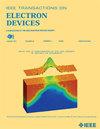Performance Improvement in Ga2O3 Schottky Photodiode With Pyroelectric Effect
IF 2.9
2区 工程技术
Q2 ENGINEERING, ELECTRICAL & ELECTRONIC
引用次数: 0
Abstract
As a potential architecture for solar-blindness ultraviolet (SBUV) detection, a relatively small responsivity of the Ga2O3 Schottky photodiode hinders their practical usage. Subjected to the severe persistent photoconductivity (PPC) effect, most existing methods can improve the responsivity of Ga2O3 photodetectors, but at the cost of the response speed. Here, an interface pyroelectric effect, induced in the depletion region on ultraviolet illumination, has been utilized for performance improvement of Ga2O3 Schottky photodiode. The influence of optical power density (PD), incident wavelength, externally applied bias, and temperature on the basic pyroelectric properties and corresponding working mechanisms are systematically investigated. Under 254-nm illumination with求助全文
约1分钟内获得全文
求助全文
来源期刊

IEEE Transactions on Electron Devices
工程技术-工程:电子与电气
CiteScore
5.80
自引率
16.10%
发文量
937
审稿时长
3.8 months
期刊介绍:
IEEE Transactions on Electron Devices publishes original and significant contributions relating to the theory, modeling, design, performance and reliability of electron and ion integrated circuit devices and interconnects, involving insulators, metals, organic materials, micro-plasmas, semiconductors, quantum-effect structures, vacuum devices, and emerging materials with applications in bioelectronics, biomedical electronics, computation, communications, displays, microelectromechanics, imaging, micro-actuators, nanoelectronics, optoelectronics, photovoltaics, power ICs and micro-sensors. Tutorial and review papers on these subjects are also published and occasional special issues appear to present a collection of papers which treat particular areas in more depth and breadth.
 求助内容:
求助内容: 应助结果提醒方式:
应助结果提醒方式:


